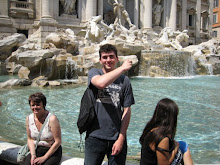Firstly, a picture of me!

Today I have decided that I will describe a part of the baptistry that resides directly across (west) of the duomo mentioned in the last blog.
Specifically under observation are the East bronze doors to the baptistry that depict scenes from the old testament also known as the תורה.
The baptistry is formally known as the "Battistero di San Giovanni" or Baptistry of St. John. Originally the baptistry was thought to be once a Roman temple to the God of War, Mars. The building was thought to have remains of Roman buildings attached. Although the building is quite old, a similar octoganol baptistry was built in the same location during the 5th century only to be renovated or rebuilt in the 6th and then a larger, present day, baptistry building was built in 1059.
Between the 14th and 16th centuries three sets of doors were commissioned. The east, south and north exits. The South set were the first commissioned and depict the life of St. John created by Leonardo d'Avanzano.
A contest was held for the commission of the North set of doors in 1401 between many famous sculptors including Donatello and Brunellschi. In the end Lorenzo Ghiberti won and spent 21 years sculpting a set of doors with scenes from the New Testament.
In 1425 Ghiberti was commissioned again for the East set of doors that would become known as the "Gates of Paradise".

 The first scene on the top left door is of Adam and Eve.
The first scene on the top left door is of Adam and Eve.
The second scene, located on the top right door is of the story of Cain and Abel.

The third scene depicts Noah and his nakedness.

The fourth scene is of Abraham and Akeydat Yitzchok.

Fifth scene depicts Isaac with Jacob and Esau (note the dogs and going out for hunting)

The sixth scene depicts Joseph and his brothers coming back from Egypt (the glass inside the bag)

Seventh scene depicts Moses receiving the ten commandments

The eighth scene is of the conquering of Jericho.

The ninth scene depicts David and Goliath.

The tenth and final scene is of Solomon and his marriage to Sheba.
Each one of these scenes interestingly can be interpreted by Catholic thought as a proof of Catholicism's validity. Each sculpture was not only chosen specifically for that purpose, but one must look at the craftmanship from an art perspective as well. The 3-d shadowing is simply amazing.
The doors that the community and the church were able to raise money for are simply amazing. The entire community at the time worked toward creating a Christian state whose ruler was "technically" Jesus. Interestingly everyone must have understood the common symbology that is so foreign to me. At the same time people must have had a different lingo and dialect simply because of their shared religion/culture. When I see all the symbols I don't understand as I walk around (such as the images of god on the doors) I wonder how the Jews must have interacted with the Christians and how much of the "lingo" they must have had to learn in order to survive (depending on the size of the community and such). I also wonder how the Jewish community was able to cooperate amongst themselves. Did the Christians understood the Jews due to their nature of studying the old testament, or simply tolerate them? As time moves on we learned about the different Jewish communities and how they were separated by their charters. I wonder how similar they actually were (realizing that they spoke different languages among other differences) and how integrated they acted with one another. I assume they felt closer (one Levantine Jew to one Italian Jew) than they would to the Christians, not because of the religion, but rather because of the implications of the religious background and how crucial religion was to the society.



No comments:
Post a Comment